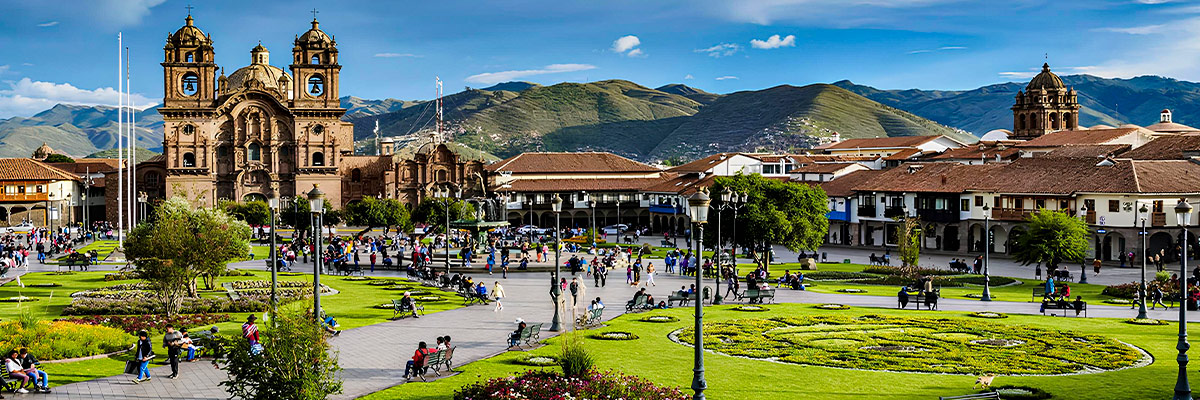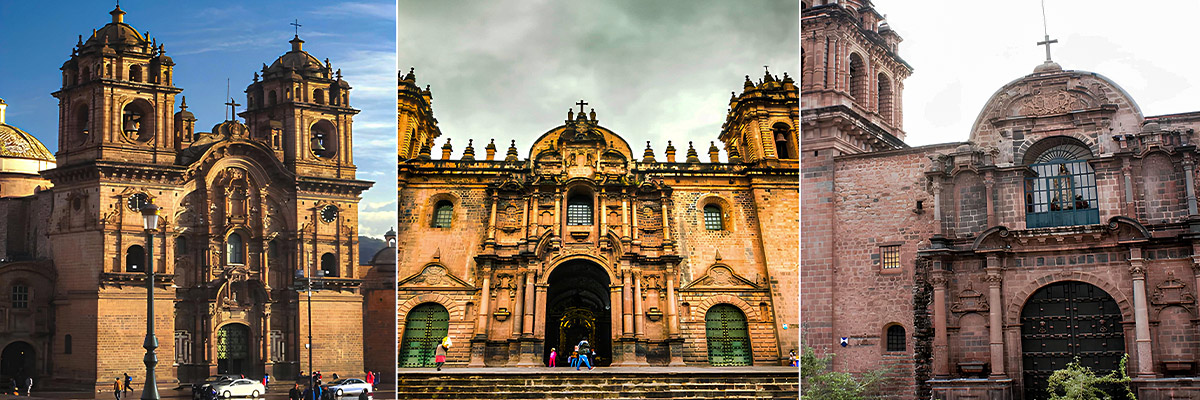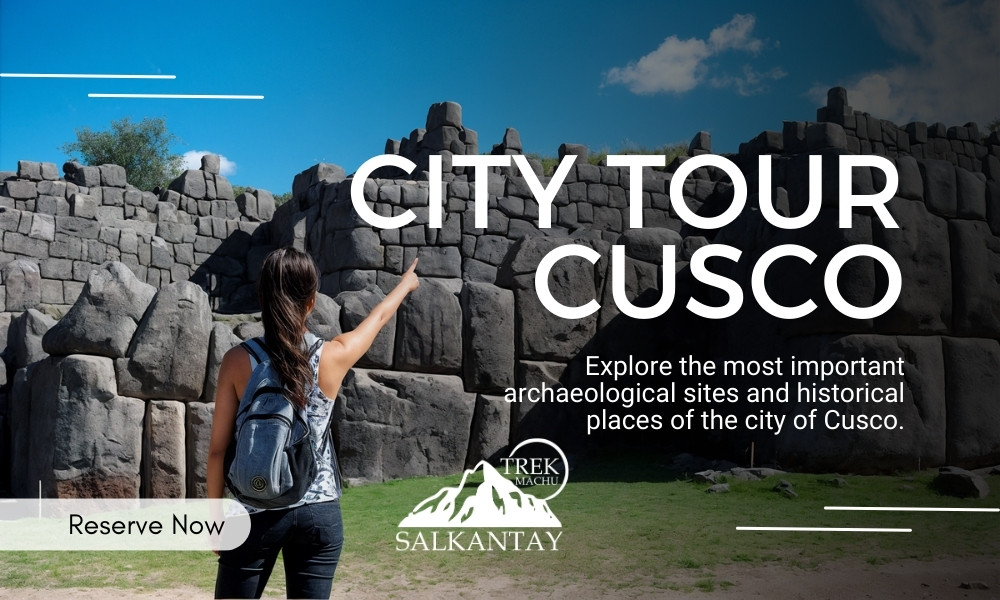
In the heart of the Plaza de Armas stands the Cusco Cathedral, one of the most important architectural jewels of Peru and a symbol of the fusion between Andean tradition and Spanish legacy. Built on the remains of the ancient palace of the Inca Viracocha, this imposing temple is a religious center and a museum that protects more than 300 works of art from the Cusco School, altars carved in wood, and altarpieces covered in gold leaf.
Considered a World Heritage Site by UNESCO, the Cathedral is an essential place for those who visit the imperial city on a City Tour Cusco. Every wall, chapel, and canvas holds fragments of history that narrate the process of cultural transformation after the arrival of the Spanish, making it a unique testimony of the artistic and spiritual richness of Cusco.
Location
The Cathedral of Cusco is located on the north side of the Plaza de Armas, in the historic center of the city.
The history of the Cathedral of Cusco
The Cathedral of Cusco is one of the most imposing and representative temples in America. Its construction, which took place between 1560 and 1664, was built on the remains of the Quishuarqancha, the ancient palace of the Inca Huiracocha. For its construction, gigantic stone blocks were used, taken from the fortress of Sacsayhuaman. Moreover, this monument, declared Cultural Heritage of the Nation, combines in an exceptional way the Gothic, Renaissance, and Baroque styles, reflecting the artistic fusion that marked the colonial era.
After the arrival of the Spanish, friar Vicente Valverde was asked to create the Diocese of Cusco, which began the construction of temples in the city. The cathedral was not without difficulties: its construction lasted for more than a century due to the search for a suitable place. Initially it was built in the space where the Church of El Triunfo is today, then the area of Cusipata was considered, but finally, in 1553, the land of the old Inca palace was chosen as the final location, where it stands today as a symbol of history, art, and faith.
Cathedral Division: The Cathedral of Cusco is divided into three temples: the church of El Triunfo (1536), the oldest, the temple of the Sagrada Familia (1723) and the Cathedral Basilica of Cusco (1560).
Church
Construction in the shape of a Latin cross and with a facade and interior in Renaissance style, in it are the best expressions of colonial goldwork, as well as a valuable collection of canvases from the Cusco School. Due to the period in which it was built, it inherits in its construction the Gothic - Renaissance of the great Spanish Cathedrals, adding the Baroque style represented in its large altarpiece portal and monumental towers.
Architecture of the Cathedral of Cusco
Rectangular in shape of basilical type, the Cathedral of Cusco has three naves: nave of the epistle, nave of the gospel and the central nave, which coincide with the three doors on the façade. It also has fourteen cruciform pillars that define the distribution of the twenty-four entrance vaults and that of the transept.
The High Altar is made entirely of silver, the Sacristy is made up of forty canvases of the Bishops and Archbishops of Cusco. Alongside it is accompanied by two auxiliary chapels, on the right side the El Triunfo church and on the left the Sagrada Familia.

Learn more about the churches surrounding the Cathedral of Cusco
- Jesus, Mary and Joseph: It is a small temple, its construction began in 1723, however it was ending in the period 1733-1735. It has images of the Sagrada Familia on its main façade and its main altar is made in the Baroque style where the altarpieces and paintings stand out. It was definitively concluded in 1737.
- The triumph: Its name is attributed to themes related to the conquest, it was named after the final victory of the Spanish against the troops of Manco Inca where they received the miraculous support of the Virgin and the Apostle Santiago. Built in 1729 - 1733, its main altar is made of finely carved stone and in its main niche you can see the "Cross of the conquest" where the ashes of the Inca Garcilaso de la Vega rest.
Attractions inside the Cathedral of Cusco
Crypts
Below the main altar you will find a small arched crypt. It contains the ashes of many deceased Cusco archbishops. It should be noted that in the church of El Triunfo the crypt is exhibited where the remains of the chronicler Inca Garcilaso de la Vega (author of ‘The Royal Commentaries of the Incas’) rest. The crypt has a portion of the ashes of the Cusco writer. The other half is in Spain.
The silver room - This section of the church is also known as 'The silver room'. It is a small side chapel that contains a varied collection of religious objects made of precious stones, gold and, above all, silver. Among these objects you will find an embossed silver coffin used to carry the statue of the 'Lord of tremors'. Another element is a large trellis used during the famous 'Corpus Christi' celebration that weighs up to 160 kilos.The painting of the Last Supper
The walls of the Cathedral are full of canvases from the famous Cusco school of painting, which originated during the colonial era. Highlights ‘The Last Supper’, a work made by the Cusco master Marcos Zapata. It measures 5 x 4 meters. The painting replaces some characteristics of the original work, due to Andean customs and beliefs, such as the vizcacha. This Andean rodent was considered the guardian of lakes and mountains.Choir stalls
The choir stalls are one of the most famous attractions of the Cathedral. It is located in the lower part of the central nave. It is made of pure cedar, in the ‘neo-archaic’ style, which was the style used in Spain between the 15th and 17th centuries. The seating is formed on three sides: by double-row seats on the sides and a single row on the central piece. The backs attached to the walls with half-relief carvings with figures of saints stand out.The Lord of the Tremors
The statue of a crucified brown Christ is an emblem of the Cathedral as well as of Christianity in Peru. An ancient legend tells that when the statue was transferred from Europe to Peru, a fierce storm threatened the lives of the people on board the ship. Despair at impending death caused the crew to put the statue on its feet. Instantly, the storm ended. Another legend tells that, after the devastating earthquake of 1650, the statue caused the aftershocks to cease. For all this, he became the main religious figure in the city of Cusco.The scristy
The sacristy is one of the most outstanding rooms in the Cathedral. It is located on the right side of the main altar. Its walls are dominated by the portraits of all the bishops of Cusco, from Vicente de Valverde (1499 - 1541) to the most recent bishops. Among the other treasures in this room, the ‘Cristo de la agonía’ stands out, a huge carved cedar altarpiece, which stands out for its realism, expressiveness and fine workmanship.

About the entry to the Cusco Cathedral
Cost of Cusco Cathedral Entrance fee
- Foreign adults: 25 Peruvian soles (8 USD approximately).
- Foreign children: 13.50 Peruvian soles (4 USD approximately).
- Foreign students (with ISIC card): 13.50 Peruvian soles (approximately 4 USD).
Visiting hours
- From Monday to Sunday, from 10 in the morning to 6 in the afternoon.
Visiting regulations
- Be quiet inside the church.
- Do not touch the works of art.
- Photographs and videos are not allowed inside the church.

If this blog was interesting, we have more info at:
Other experiences near Cusco
Beyond the majesty of Machu Picchu, the surroundings of Cusco offer a variety of experiences that allow you to get to know the culture, history, and landscapes of Andean Peru up close. From traditional towns to little-explored natural wonders, there is a lot to discover just a few kilometers from the imperial city. If you are looking for new adventures outside the usual, here we present the places you can't miss:
Inca Trail, Machu Picchu and more
